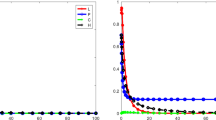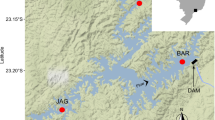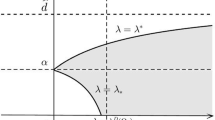Abstract
Special situations, which are difficult to predict and to model by traditional methods, develop rapidly in population processes. A sudden collapse of commercial fish stocks, in addition to outbreaks of forest pests, are among the most economically significant nonlinear phenomena in ecosystems. According to systems analysis of statistical data on the dynamics of catches, the transitional stages of rapid degradation in completely different species of fish and aquatic invertebrates occur in a similar way. The most representative stages of the development of fish resources collapse have been distinguished. Restoration of the already critically depleted aquatic bioresources occurs at different rates. Based on the method of dynamically redefinable hybrid computational structure, we considered situations of collapse that occurred with crab off the coast of Alaska and northern cod off the coast of Canadian provinces of Newfoundland and Labrador. The resulting computational scenarios for collapse manifestation consist of three stages, all the way up to the degradation of bioresources. Bifurcations are implemented purposefully and follow the logic of the process. The modeling method is generalized for cases with stationary food resources and with oscillatory dynamics of food organisms.
Similar content being viewed by others
References
A. Yu. Perevaryukha, “Continuous model for the devastating oscillation dynamics of local forest pest populations in Canada,” Cybern. Syst. Analysis, Vol. 55, No. 1, 141–152 (2019).
C. R. Hennigar, J. S. Wilson, D. A. MacLean, and R. G. Wagner, “Applying a spruce budworm decision support system to maine: Projecting spruce-fir volume impacts under alternative management and outbreak scenarios,” Journal of Forestry, Vol. 109, Iss. 6, 332–342 (2011).
A. Yu. Perevaryukha, “Modeling abrupt changes in population dynamics with two threshold states,” Cybern. Syst. Analysis, Vol. 52, No. 4, 623–630 (2016).
V. M. Zayats, “Construction and analysis of a model of a discrete oscillatory system,” Cybern. Syst. Analysis, Vol. 36, No. 4, 610–613 (2000).
E. Catsigeras and H. Enrich, “Persistence of the Feigenbaum attractor in one-parameter families,” Commun. Math. Phys., Vol. 207, No. 3, 621–640 (1999).
V. V. Skobelev and V. G. Skobelev, “Some problems of analysis of hybrid automata,” Cybern. Syst. Analysis, Vol. 54, No. 4, 517–526 (2018).
S. Ya. Reznik, N. A. Belyakova, A. N. Ovchinnikov, and A. A. Ovchinnikova, “The influence of density-dependent factors on larval development in native and invasive populations of Harmonia axyridis (Pall.) (Coleoptera, Coccinellidae),” Entomol. Rev., Vol. 97, No. 7, 847–852 (2017).
I. T. Selezov, “Hopf bifurcation in coastal ecogeosystems,” Cybern. Syst. Analysis, Vol. 52, No. 4, 546–554 (2016).
W. E. Ricker, “Stock and recruitment,” J. of the Fisheries Research Board of Canada, Vol. 11, No. 5, 559–623 (1954).
A. N. Frolov, The beet webworm Loxostege sticticalis L. (Lepidoptera, Crambidae) in the focus of agricultural entomology objectives: I. The periodicity of pest outbreaks,” Entomol. Rev., Vol. 95, No. 2, 147–156 (2015).
P. V. Veshchev and G. I. Guteneva, “Efficiency of natural reproduction of sturgeons in the lower Volga under current conditions,” Russian J. of Ecology, Vol. 43, No. 2, 142–147 (2012).
D. Singer, “Stable orbits and bifurcation of maps of the interval,” SIAM J. Appl. Math., Vol. 35, No. 2, 260–267 (1978).
M. J. Feigenbaum, “The transition to aperiodic behavior in turbulent systems,” Commun. Math. Phys., Vol. 77, No. 1, 65–86 (1980).
J. Roughgarden and F. Smith, “Why fisheries collapse and what to do about it,” Proc. Natl. Acad. Sci. USA, Vol. 93, 5078–5083 (1996).
R. A. Myers, J. A. Hutchings, and N. J. Barrowman, “Why do fish stocks collapse? The example of cod in Atlantic Canada,” Ecol. Appl., Vol. 7, No. 1, 91–106 (1997)
P. A. Larkin, “An epitaph for the concept of Maximum sustained yield,” Transac. Amer. Fish. Soc., Vol. 106, No. 1, 1–11 (1977).
R. Barrett, “Population dynamics of the Peruvian anchovy,” Mathematical Modelling, Vol. 6, Iss. 6, 525–548 (1985).
J. Guckenheimer, “Sensitive dependence on initial conditions for one dimensional maps,” Commun. Math. Phys., Vol. 70, No. 2, 133–160 (1979 ).
I. V. Sergienko, “Main directions in the development of informatics,” Cybern. Syst. Analysis, Vol. 33, No. 6, 757–827 (1997).
A. V. Nikitina and A. A. Semenyakina, “Mathematical modeling of eutrophication processes in Azov Sea on supercomputers,” Computational Mathematics and Information Technologies, No. 1, 82–101 (2017).
V. I. Ponomarev, E. M. Andreeva, and N. V. Shatalin, “Group effect in the gypsy moth (Lymantria dispar, Lepidoptera, Lymantriidae) related to the population characteristics and food composition,” Entomol. Rev., Vol. 89, No. 3, 257–263 (2009). 151
Author information
Authors and Affiliations
Corresponding author
Additional information
Translated from Kibernetika i Sistemnyi Analiz, No. 1, January–February, 2020, pp. 163–177.
Rights and permissions
About this article
Cite this article
Perevaryukha, A.Y. Modeling the Scenarios of Collapse of the Commercial Aquatic Populations off the Coast of Canada and Alaska*. Cybern Syst Anal 56, 139–151 (2020). https://doi.org/10.1007/s10559-020-00229-6
Received:
Published:
Issue Date:
DOI: https://doi.org/10.1007/s10559-020-00229-6




